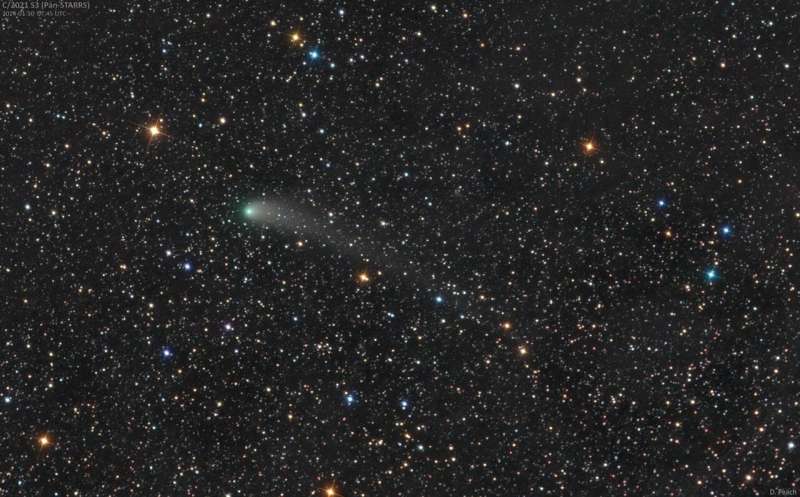This article has been reviewed according to Science X's editorial process and policies. Editors have highlighted the following attributes while ensuring the content's credibility:
fact-checked
trusted source
proofread
Capturing a comet's tail to keep Earth safe from the sun

A comet is set to pass by Earth this spring, and it may be missing its tail.
The comet poses no danger to Earth—it is about the same distance from our planet as we are from the sun—but scientists need images of C/2021 S3 Pannstars from amateur astronomers to improve forecasts of space weather. These forecasts are vital to prevent problems caused by solar winds, which are streams of particles containing solar storms that can damage technology in space and on Earth.
Sarah Watson, the University of Reading Ph.D. researcher leading the project, said, "What we are expecting to see may look rather unusual. When we talk about comets, people often think of a large, bright sphere followed by a long thin tail."
"The comet we are observing may look different as its tail could 'detach' as it is buffeted by solar winds."
"We need lots of timed photos of the comet to build up a picture of its journey through our solar system. This is a fantastic opportunity for amateur astronomers to get out their telescopes, capture a truly spectacular cosmic moment, and make a big contribution to some important science."
Spot the comet
The comet has been visible in the UK night sky since Wednesday, 14 February, but will be easier for astronomers to spot in the coming weeks as it appears further away from the sun and stays above the horizon in the night sky for longer. The comet will not be visible to the naked eye, so stargazers will need a small telescope to which they can attach a camera or a camera with a big lens to capture the comet. It is expected to be in view until the end of March.
A full guide on how to photograph a comet can be found on the BBC Sky at Night Magazine website.
Photographers should look out for a fuzzy object to identify the head of the comet and a bright dash behind it to identify the tail. Researchers are eager to receive snaps of the comet's broken tail in particular, and should photographers manage to capture the comet; scientists will also need information on the image location and time.
Data and images should be sent to s.r.watson@pgr.reading.ac.uk, and the best photographs will be sent to the British Astronomical Association to be archived.
Space windsocks
Comets are sometimes referred to as cosmic 'windsocks' as they can indicate the direction and strength of the solar wind in space, similar to how a windsock shows the direction and strength of the wind. Images of the comet will enable the research team to record data about solar wind conditions local to the comet. If the tail detaches from the comet or appears to wobble, the team can determine there was an increase in solar wind activity nearby.
Solar wind contains streams of charged particles from the sun, some of which are energetic enough to damage satellites in space and harm astronauts and high-altitude aircrew. When solar wind hits the Earth's magnetosphere, communications technology can be sent haywire. By improving our understanding of solar wind, scientists can also improve space weather forecasts.
A University of Reading-led survey from 2023 found that nine in ten space weather experts agree that without accurate forecasting of space weather, Earth could suffer serious damage to its infrastructure.
Provided by University of Reading

















